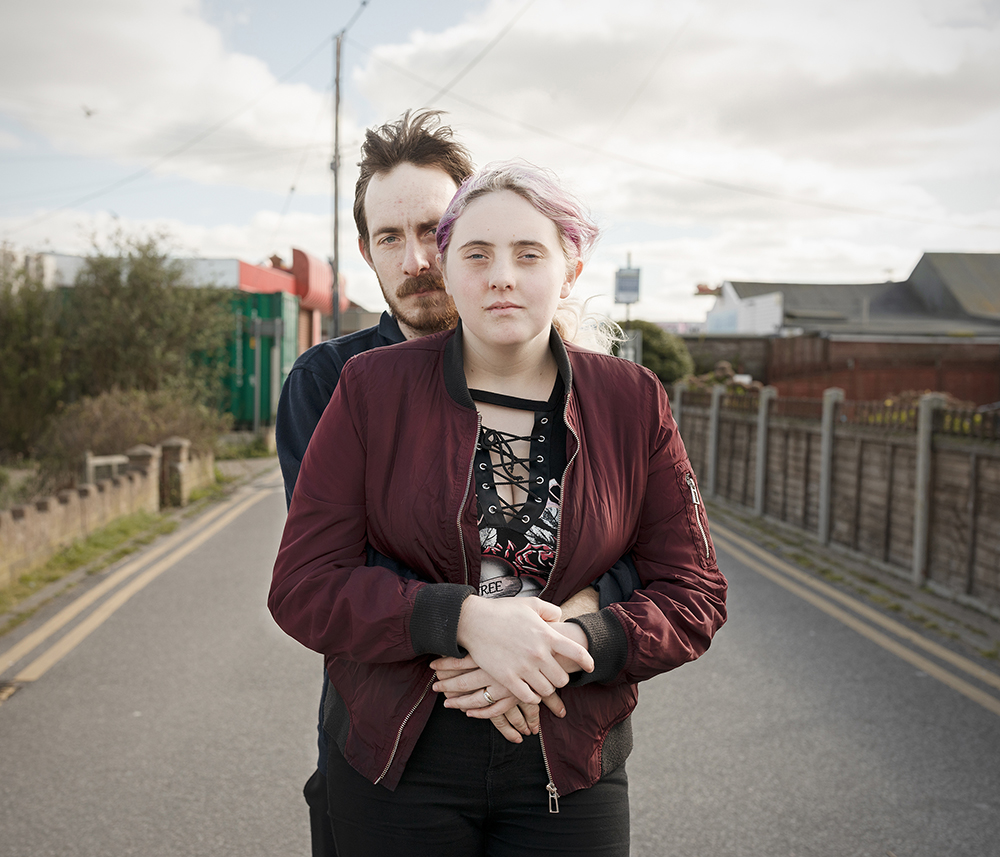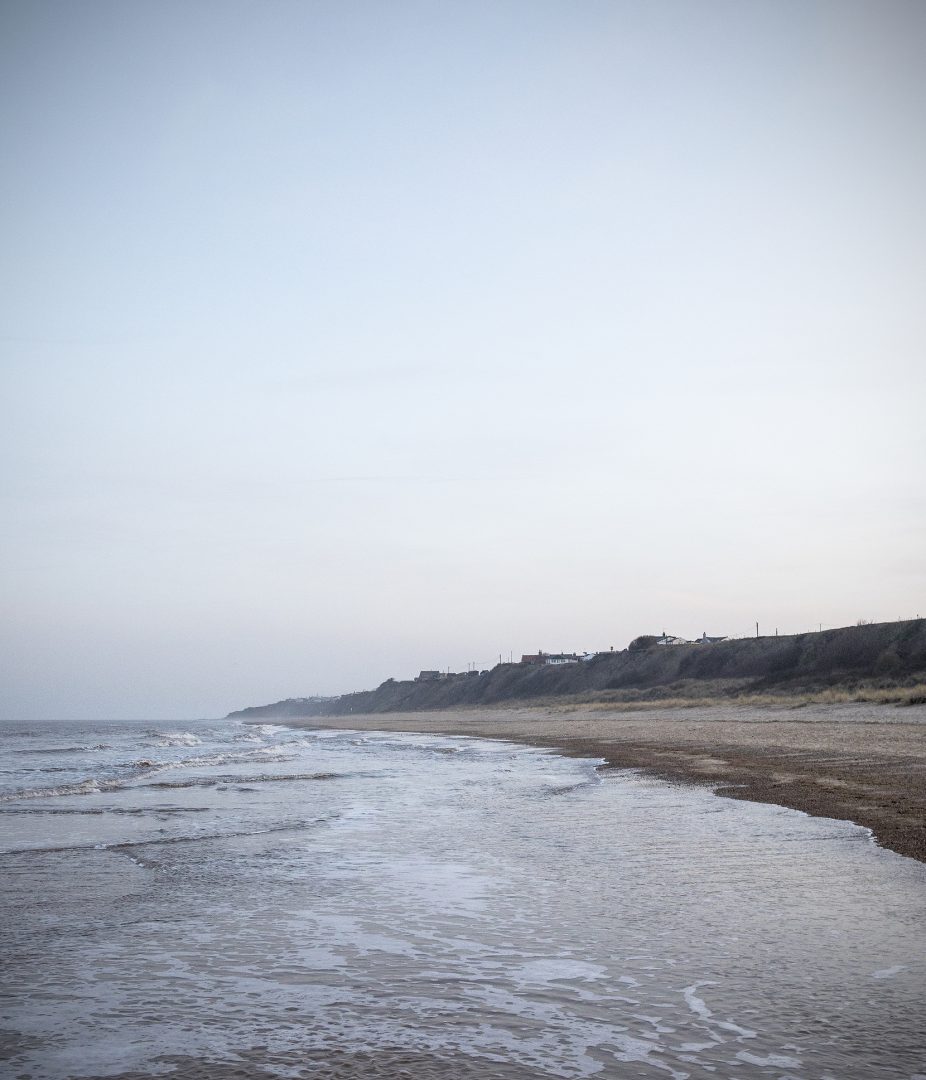Hemsby, going down in slow motion

Imagine you are a teenager and the village on the coast where you and your family have lived for generations is sinking into the ocean piece by piece. Impressive portraits like these can be seen in the melancholic and oppressive series HEMSBY by photographer Maren Katerbau, on view at the DIA project room in Munich from February 14th.
Being located on the coast of Norfolk in Great Britain, Hemsby is one of the places where the threat of climate change is “already” reality, undeniably.
The past years’ rising sea level and strong storms with floods -“Beast from the East” as the villagers call them- are direct consequences of climate change.

When you look at the photographs, you feel like a spectator at the theatre: the compositions’ horizon lines recall a theatrical backdrop, like a drama in slow motion and in four acts that unfolds before our eyes. The protagonists are caught in the piece, silent, rigid, but also determined.
We spoke to Maren about HEMSBY and its residents.
On the way to Hemsby

In your HEMSBY series, you took pictures of a village on the coast of Norfolk that is slowly but surely sinking due to climate change.
How did it come about?
I am very interested in architecture and topography, history, politics, culture and human coexistence.
Many years ago I had already started to describe places and their inhabitants with photography.
For me, architecture and photography are naturally tied together and both are able to reflect historical and political realities as well as to preserve cultural heritage.
At the end of 2018, a friend living in London told me about the situation in Hemsby.
Quickly it became clear to me that I had to go there and take pictures of the slowly disappearing village.
How did you arrive at photography initially?
About 23 years ago, I developed in the darkroom my first own black and white film, and immediately after it was clear to me that I wanted to be a photographer.
Please tell us how you got into conversation with the residents and what your impressions were.
First I started to photograph the architecture and the landscape. I went through the village of Hemsby again and again which gave me a comprehensive picture of the situation there and of the consequences of coastal erosion.
After a few days I knocked on doors or asked people on the street to tell me their story and let me portray them.

What is left of Hemsby?
Little attention has been paid to the Norfolk coast and the problem of coastal erosion in England so far and there is a huge lack of support.
With an expected sea level rise of around one meter in the next decades, due to high costs the authorities in charge no longer want to invest in flood protection.
They would however support resettling the residents.
Real estate prices in Hemsby have dropped increasingly given Hemsby’s unpromising future.
Whoever sells now would hardly make a profit at all.
Even so, the residents of Hemsby want both to grow old in their village, and make sure their families inherit their houses and properties.
Maren Katerbau, HEMSBY, 2019

For many residents of Hemsby, not only is retirement at stake, but also young people and the village as a whole face the threat of an uncertain future.

Do you still think of Hemsby now that you are back home?
Yes sure. I still have contact with some of the people I portrayed there. A coastal protection system has not been able to be built to date due to a lack of financial resources.
After storms and floods tore several meters off the sandy cliff edge in recent years, several houses have already sunk into the sea.



Due to climate change and the rising sea level, coastal erosion is on the rise in Hemsby.
The homes and economic basis for approximately 4,000 villagers living from tourism is being gradually washed away.
Concern for the residents of this poor area remains.
For these locals, Hemsby could become only a temporary home.

I also inspect my own environmental actions closely which has often made me more aware of my responsibility in this respect.




Would you describe yourself as spiritual, does that flow in any way into your work?
I assume that all people are connected in some way and by extension that they have the same place of origin.
This attitude or this feeling of solidarity flows continuously into my photographic work.

How do you see your role as a photographer when it comes to becoming active in relation to climate change?
Are you more optimistic or negative about it?
I certainly cannot stop climate change with my work as a photographer. But I can at least make it visible and thereby hope for changes in society.
This aspect of my work makes me positive.
Epilogue: Shortly before the publication of this interview, one of the villagers with whom Maren Katerbau is still in contact (a former soldier, now retired) had sent her a current newspaper article which reads:
(Storm Chiara reached Great Britain a few days ago with heavy rains and gusts of wind up to 145 km).
It is a report of his struggle to save from the floods the house in which he would like to spend his retirement.
Headline: “LAST MAN STANDING”
Maren Katerbau – HEMSBY
VERNISSAGE 14.02.2020, 19 Uhr
AUSSTELLUNG: 15.02. – 06.03.2020
DIA Raum für Kunst | Georgenstrasse 72 | 80799 München
About Maren Katerbau:
Maren Katerbau is a photographer based in Berlin and Stuttgart. Her work focuses on portrait, architecture and visual storytelling. She was educated at the Bielefeld University of Applied Sciences, Zurich University of the Arts, Hamburg University of Applied Sciences and also has finished the masterclass with Ute Mahler & Ingo Taubhorn at the Ostkreuz School of Photography in Berlin.
Author: Esther Harrison
